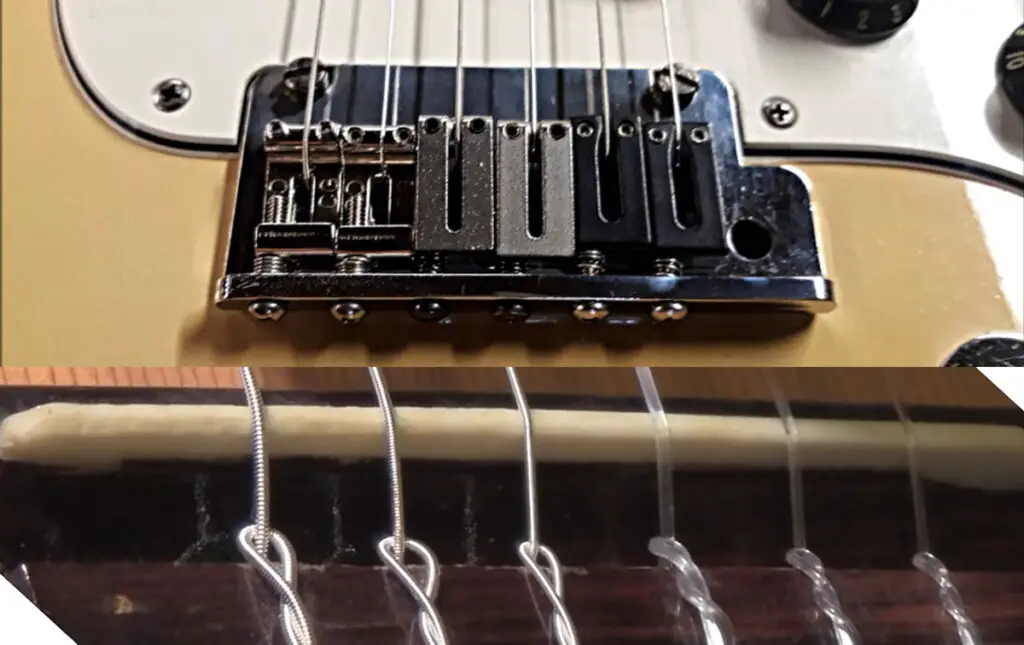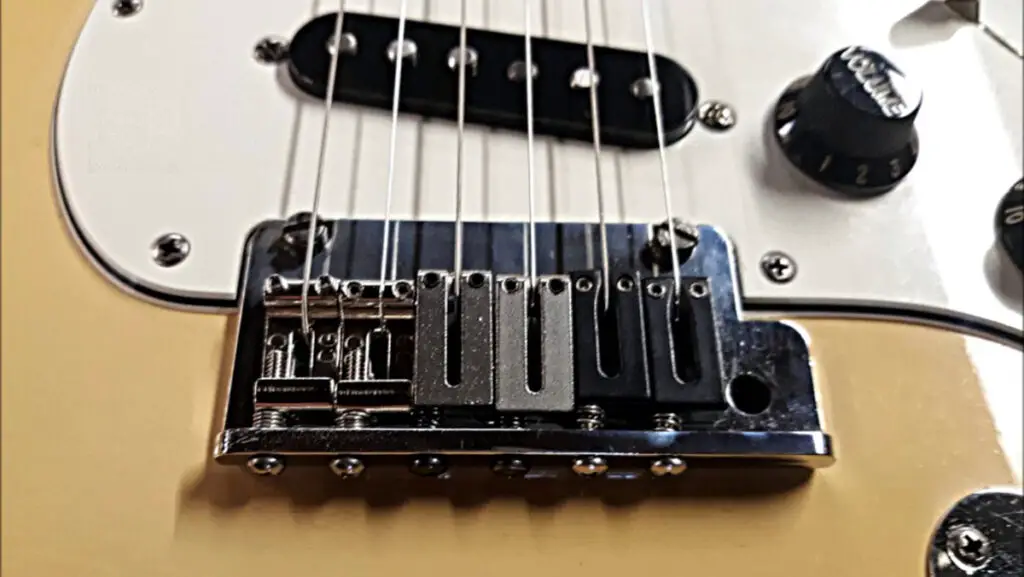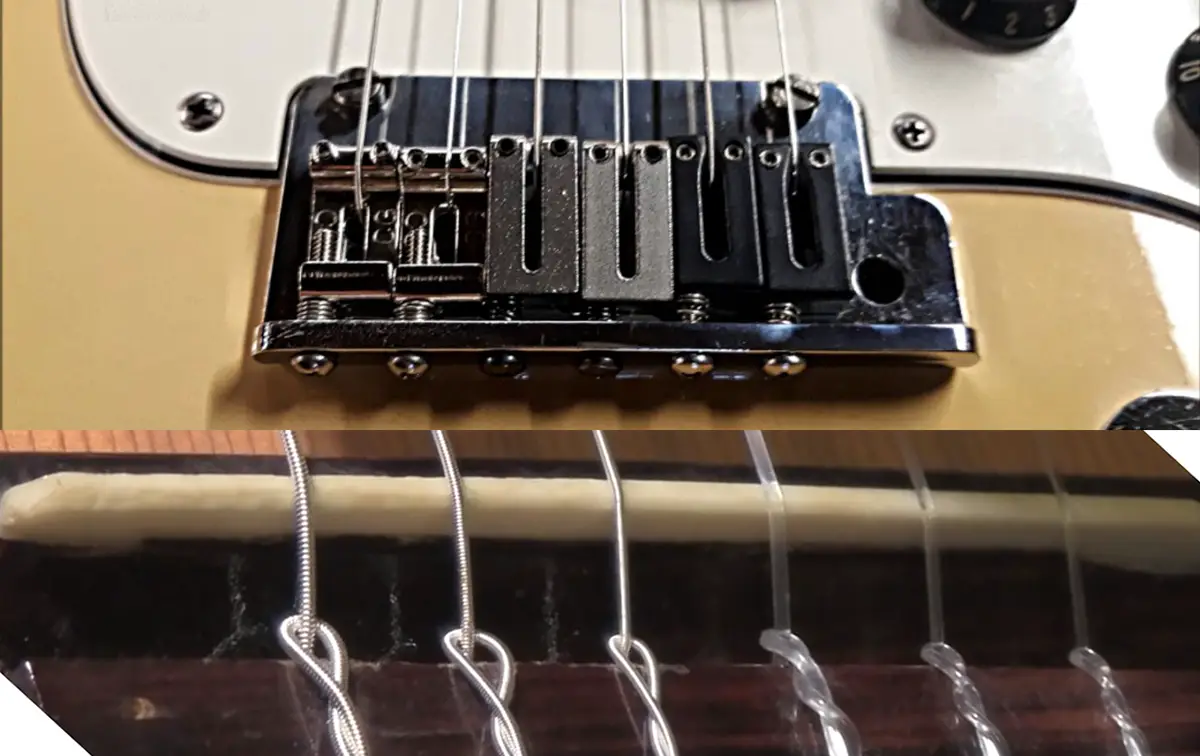The guitar, a favorite instrument for many music enthusiasts, has a complex structure that contributes to its rich sound and playability. Each component, from the body to the smallest screw, has its purpose and role in creating the instrument’s overall sound.
One component that plays a crucial but often overlooked role is the guitar saddle. This small piece, a part of the bridge, plays a pivotal part in dictating the guitar’s action, intonation, and tone.
What is the saddle on a guitar?
The saddle on a guitar is a component of the bridge that supports the strings, helps determine their height off the fretboard (action), and plays a crucial role in transmitting string vibrations to the body of the guitar, affecting its tone and intonation.
In this article, we’ll look into the intricacies of the guitar saddle, exploring its function, the impact of its material and position, and the effects of adjusting it. We’ll also discuss the differences between the saddle and the bridge and why a guitar wouldn’t function properly without a saddle.

What Is The Saddle On A Guitar?
The saddle on a guitar is a component of the bridge that physically supports the strings. It also plays a significant role in the transmission of string vibrations to the soundboard or body of the guitar. The saddle can be made from various materials, such as bone, plastic, or synthetic composites.
In addition to supporting the strings, the saddle also helps determine the action (the distance between the strings and the fretboard) and intonation (the accuracy of the pitch across the length of the string) of the guitar. The position, height, and material of the saddle can all affect the tone and playability of the guitar.
On acoustic guitars, the saddle is typically a small piece of material that sits in a slot in the bridge, with the strings running over it. On electric guitars, there may be individually adjustable saddles for each string, allowing for more precise control over the action and intonation.
What Is A Compensated Guitar Saddle?
A compensated guitar saddle is designed to improve the instrument’s intonation by adjusting the effective length of each string to account for discrepancies caused by string thickness and tension, ensuring that the guitar stays in tune across the entire length of the fretboard.
In theory, when you shorten a string (by pressing it down onto a fret), it should produce a higher pitch at a specific frequency. This works perfectly on a theoretical, infinitely thin string, but real-world guitar strings have a certain thickness (or “diameter”), and they’re under tension. This means they don’t behave exactly as the theory predicts.
This discrepancy arises because real-world strings are not ideal mathematical strings. They have thickness and stiffness, and these properties, along with the tension on the string, affect the pitch of the notes. The effect becomes more noticeable as you play notes further up the fretboard.
One of the effects of this real-world behavior is that the guitar’s intonation—its ability to stay in tune up and down the neck—can be off. This is where compensated saddles come in.
Compensated saddles are designed to adjust the effective length of each string to counteract these discrepancies and improve intonation.
To compensate for these factors, the saddle is strategically shaped or positioned to slightly lengthen or shorten the effective vibrating length of each string.
Often, the thicker strings will need more compensation than the thinner ones because their greater stiffness has a larger effect on the pitch.
This compensation allows each fretted note to stay more perfectly in tune with the equivalent open-string note, which improves the overall intonation of the guitar.
Properly executed, it means that your guitar will sound more in tune, whether you’re playing an open chord, a barre chord, or a solo high up the neck.
The amount of compensation required can vary depending on several factors, such as the string gauge, the scale length of the guitar, and the player’s style and preferences.
Compensation becomes more crucial with steel-string acoustic guitars and electric guitars. Classical guitars with nylon strings have less need for compensation because nylon strings have different physical properties.
Why The Thickness, Stiffness And String Tension Effect The Intonation
The pitch of a vibrating string, such as a guitar string, is determined by three factors: its length, its tension, and its mass per unit length (which is related to the thickness and density of the string). This is described by the basic physics of vibrating strings.
When you fret a note on a guitar, you’re effectively shortening the string, which raises the pitch.
However, the actual pitch produced by the string doesn’t change exactly as predicted by the simple theory due to the real-world properties of the strings.
- Thickness and Stiffness
- Real guitar strings are not infinitesimally thin but have a certain thickness. This thickness means that when you fret a string, the string has to be stretched slightly to reach the fret.
- This stretching increases the tension in the string, which raises the pitch slightly. This effect is more pronounced for thicker and stiffer strings.
- Tension
- The tension in a guitar string is not distributed evenly when you fret a note, especially if you press the string down hard. This uneven tension can cause the pitch to be slightly sharp compared to the theoretical prediction.
These factors mean that a guitar string doesn’t behave exactly like an idealized, perfectly flexible string. They cause the fretted notes to be slightly sharp compared to the theoretical prediction, and this effect becomes more pronounced as you move up the fretboard.
The role of the compensated saddle is to correct these discrepancies. By adjusting the position of the saddle, you can slightly lengthen the effective vibrating length of the string, which compensates for the slight sharpness and improves the intonation.
Why Not Move The Location Of The Frets?
Adjusting the fret locations could theoretically address some of the intonation issues caused by string thickness and tension. However, this would be a much more complex solution than using a compensated saddle for several reasons:
- Standardization
- Fret locations are standardized based on musical theory and the desired scale length of the instrument. This standardization allows for consistent playability across different guitars.
- Versatility
- Different strings (even on the same guitar) will need different amounts of compensation due to differences in thickness and material.
- This means that if you adjust the fret locations to compensate for one set of strings, it might not work for another set. The saddle, on the other hand, can be easily adjusted when you change strings or want to fine-tune your intonation.
- Complexity
- Changing the fret locations would require refretting the entire guitar, which is a complex process that could potentially damage the fretboard. In contrast, adjusting the saddle is a comparatively simple and non-invasive procedure.
While moving the frets could theoretically address intonation issues, using a compensated saddle is a much simpler, more versatile, and more practical solution.

What Is The Difference Between a Saddle And a Bridge On Guitar?
The terms “saddle” and “bridge” refer to different parts of a guitar, and both are crucial for the instrument’s function.
The bridge is a larger component that is typically attached to the body of the guitar. Its primary function is to anchor the strings to the body of the guitar. The bridge can be found on both acoustic and electric guitars, though its design and material may vary.
On an electric guitar, the bridge might also have pickup components or other electronics attached to it.
The saddle, on the other hand, is a smaller component that is a part of the bridge. It’s the part that the strings rest on before they’re anchored to the bridge.
The saddle is crucial for determining the height of the strings above the fretboard (known as the “action”) and for transmitting the vibrations of the strings to the guitar’s body, influencing the instrument’s tone.
The saddle is a part of the bridge, but they serve different functions and aren’t the same thing.
What Does Adjusting The Saddles On A Guitar Do?
Adjusting the saddles on a guitar can impact several aspects of the instrument’s playability and sound. Here are the primary effects:
Intonation
The primary reason to adjust the saddles is to set the guitar’s intonation. Intonation refers to the guitar’s ability to stay in tune across the entire length of the fretboard.
When you adjust the saddle, you’re effectively changing the length of the vibrating portion of the string. If a guitar’s intonation is off, a note played on an open string might be in tune, but the same note fretted higher up the neck might be sharp or flat.
By moving the saddle forward or backward, you can correct this issue.
Action
The height of the saddles can also influence the guitar’s action, which is the distance between the strings and the fretboard.
Raising the saddles increases the action, making the strings higher off the fretboard and potentially harder to press down, but reducing the likelihood of fret buzz.
Lowering the saddles decreases the action, making the strings easier to press down but increasing the risk of fret buzz.
String Spacing
On some guitars, particularly electrics, the individual saddles can be adjusted sideways. This adjustment changes the spacing between the strings, allowing for a more personalized setup based on the player’s preference.
Adjusting saddles is a delicate process that can drastically affect a guitar’s playability and sound. If you’re not confident in doing this yourself, it’s often best to take your guitar to a professional luthier for a setup.
What Is The Correct Saddle Position On A Guitar?
The “correct” saddle position on a guitar can vary greatly depending on the specific instrument and the player’s preferences.
The general goal when positioning the saddle is to achieve good intonation, which means the guitar should stay in tune across the entire length of the fretboard, and a comfortable action.
Adjusting The Saddle For Intonation
To adjust the saddle for proper intonation, you can follow these steps:
- Tune your guitar to your preferred tuning using an accurate electronic tuner.
- Play an open string and ensure it’s perfectly in tune.
- Now play the same string fretted at the 12th fret (which should be an octave higher than the open string). If the fretted note is sharp (too high), you need to lengthen the string by moving the saddle towards the tail end of the guitar. If the fretted note is flat (too low), you need to shorten the string by moving the saddle towards the neck of the guitar.
- Repeat this process for each string.
Remember, adjusting the saddle can also affect the action (the height of the strings above the fretboard) and potentially the string spacing, so it’s a delicate process.
For acoustic guitars with a single-piece saddle, adjusting intonation can be more complex and might require reshaping the saddle or even the bridge, which should definitely be done by a professional.
Adjusting The Saddle For Action
To adjust the saddle for proper action, you can follow these steps:
- Check the Current Action: First, measure the current action at the 12th fret. This can be done with a ruler or a specialized string action gauge. The exact desired action can vary based on personal preference and playing style, but a common action is around 2mm for the high E string and 2.5mm for the low E string.
- Loosen the Strings: Before adjusting the saddle, loosen the strings to relieve tension. This makes it easier to adjust the saddle and reduces the risk of damaging the strings or the guitar.
- Adjust the Saddle: On many electric guitars and some acoustics, you can adjust the height of the saddle directly. This is often done with a small Allen wrench turning screws at the saddle. To lower the action, lower the saddle. To raise the action, raise the saddle.
- Retune and Recheck: After adjusting the saddle, retune the guitar and recheck the action at the 12th fret. You may need to repeat the process a few times to get the action exactly where you want it.
- Check for Fret Buzz: After adjusting the action, play the guitar and listen for fret buzz. If the action is too low, the strings may buzz against the frets, especially when playing hard. If this happens, you’ll need to raise the action slightly.
Adjusting the action can also affect the intonation of the guitar, so you may need to adjust the saddle position (forward or backward) after adjusting the height.
Can You Play Guitar Without a Saddle?
Technically, you can play the guitar without a saddle, but it’s not recommended, and the guitar will not function as intended. Here’s why:
- Intonation and Action: The saddle plays a key role in setting the intonation and action of your guitar. Without it, you’ll likely find that your guitar doesn’t stay in tune up and down the neck (poor intonation) and the strings are too close to the fretboard (low action), leading to fret buzz.
- Tone and Volume: The saddle helps transmit the vibrations from the strings to the body of the guitar (or the top, in the case of an acoustic). Without the saddle, the volume and tone of your guitar could be significantly diminished.
- String Stability: The saddle helps keep the strings in place. Without it, the strings may move around more than they should, which could cause tuning stability issues and make the guitar more difficult to play.
- Potential Damage: Depending on the design of the guitar, playing without a saddle could potentially damage the bridge, the strings, or other parts of the guitar.
While it might be possible to strum the strings and make some sound without a saddle, the lack of a saddle would cause significant issues with the playability, sound, and potentially the condition of the guitar. It’s strongly recommended to use a guitar with a properly fitted saddle.

Conclusion
The guitar saddle, though small, plays a pivotal role in shaping the sound, playability, and overall functionality of your guitar. From setting the correct intonation and action to impacting the tone and even the string spacing, the saddle’s influence extends beyond its humble size.
Understanding its function and how to properly adjust it can significantly enhance your playing experience and allow you to tailor your instrument to your personal preferences.
Remember, while adjusting the saddle yourself can be a rewarding part of maintaining your instrument, don’t hesitate to seek professional help if you’re unsure. Proper setup can make a world of difference in your guitar’s performance.
In the end, a well-set saddle not only ensures your guitar is in tune across the entire fretboard but also contributes to the comfort and ease of playing. So, never underestimate the power of this tiny component in your guitar’s anatomy. Here’s to many more harmonious strums and riffs on your well-tuned instrument!


